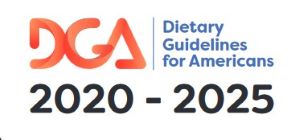What Have the U.S. Dietary Guidelines Said About Vegan and Vegetarian Diets? A Look Back
Every five years, starting in 1980, the Department of Health and Human Services and the U.S. Department of Agriculture (USDA) have issued Dietary Guidelines for Americans. Each edition of the Dietary Guidelines provides the federal governments’ recommendations for what Americans should eat and drink to meet nutrient needs, promote health, and prevent disease. These recommendations have big effects on nutrition policy and federal programs. We’ll be taking a close look at the process for developing Dietary Guidelines and the ways that they are used in the coming weeks.
This post looks at the early days of the Dietary Guidelines to see what they’ve said about plant-based, vegetarian, and vegan diets.
The first two Dietary Guidelines did not mention vegetarian or vegan diets. The third edition (1990) recommended choosing a diet with plenty of vegetables, fruits, and grain products. This advice was expanded in 1995, when the Food Guide Pyramid, which illustrated the concept of plant foods as the foundation of healthful diets, was introduced along with the 1995 Dietary Guidelines.
Vegetarian diets were mentioned for the first time in 1995 when the text of the Dietary Guidelines said, “Vegetarian diets are consistent with the Dietary Guidelines for Americans and can meet Recommended Dietary Allowances for nutrients.” This statement was also included in the 2000 Dietary Guidelines. In 1995, vegetarians were encouraged to pay special attention to sources of iron, zinc, and B vitamins; vegans were told to use vitamin B12 supplements and to ensure adequacy of vitamin D and calcium. There was an acknowledgement that “some Americans eat vegetarian diets for reasons of culture, belief, or health” but no attempt was made to promote vegetarian diets as a healthier choice.
In 2000, for the first time, calcium sources for those avoiding dairy products, were mentioned in the Dietary Guidelines. Sources included soy-based beverages with added calcium, tofu (if made with calcium sulfate), and dark green leafy vegetables such as collards and turnip greens.
The 2005 Dietary Guidelines included a section on vegetarian diets that included explanations of different types of vegetarian diets, and described how vegetarians could select nuts, seeds, and legumes (and eggs if desired) from what was called the “Meat and Beans Group.”
In 2010 the text of the Dietary Guidelines spoke positively about vegetarian diets, reporting that vegetarian eating patterns have been associated with lower rates of obesity, a reduction in blood pressure, and a reduced risk of cardiovascular disease. This edition of the Dietary Guidelines included vegan and lacto-ovo vegetarian versions of the USDA Food Patterns. For twelve calorie levels, ranging from 1000-3200 calories, the 2010 Dietary Guidelines provided recommended servings from each food group for lacto-ovo vegetarians and vegans. In addition, in 2010, the Dietary Guidelines recommended making half your plate fruits and vegetables and included beans and peas, soy products, and unsalted nuts and seeds in the list of “protein foods.”
“A healthy vegetarian eating pattern” was identified as “one of three “healthy eating patterns that can be adapted based on cultural and personal preferences” in 2015. The “Healthy Vegetarian Eating Pattern,” as described by the 2015-2020 Dietary Guidelines, includes vegetables, fruits, grains, dairy or fortified soymilk (or other plant-based dairy substitutes), legumes including soy products, and nuts and seeds. The eating pattern was developed based on foods and amounts of foods eaten by self-described vegetarians in the United States based on a large national study.
As it did in 2015, the 2020 Dietary Guidelines endorses “a healthy vegetarian dietary pattern.” There are versions of this plan for ages 1 year and older. The text of the 2020-2025 Dietary Guidelines reminds vegetarians and others eating few animal products to consider use of a vitamin B12 supplement. This edition of the Dietary Guidelines also encourages all Americans to eat more plant foods including dried beans, whole grains, fruits, vegetables, and nuts.
To read the Vegetarian Resource Group’s comments that were submitted to the committees developing
Dietary Guidelines see:
VRG Testimony on 2025-2030 Dietary Guidelines
The Vegetarian Resource Group Sends in Testimony Concerning the 2020 Dietary Guidelines
VRG Submits Comments to the 2015 Dietary Guidelines Advisory Committee
The Vegetarian Resource Groups Comments on the Dietary Guidelines Proposal (2015)
VRG Testifies for the 2010 Dietary Guidelines
VRG’s Comments on USDA’s Dietary Guidelines 2010
VRG Presents at Dietary Guidelines Summit (1998)
To read more about Dietary Guidelines in the United States see:
2020-2025 Dietary Guidelines for Americans Released; Has Both Positive and Negative Features
2015-2020 Dietary Guidelines Released
2010 Dietary Guidelines Released
To read more about Dietary Guidelines in other countries see:
Do International Dietary Guidelines Promote Vegan/Vegetarian Diets?
Mexican 2023 Dietary Guidelines Recommend that 92% of our Plate Should be Plant Foods
Spain’s Dietary Recommendations: Less Meat, More Plant Foods

